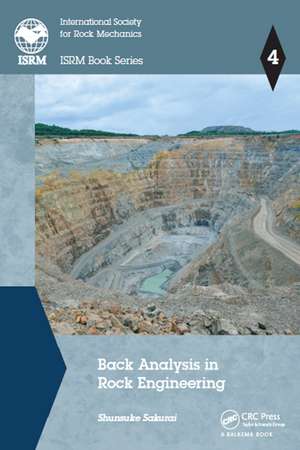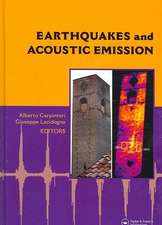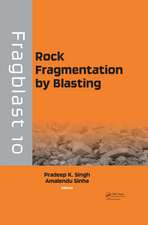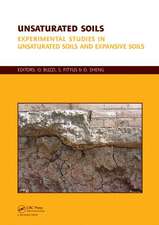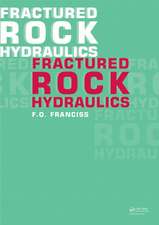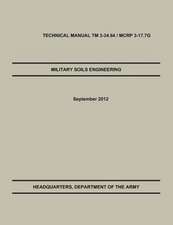Back Analysis in Rock Engineering: ISRM Book Series
Autor Shunsuke Sakuraien Limba Engleză Paperback – 30 iun 2021
The author has developed both the concepts of “critical strain” and of the “anisotropic parameter” of rocks, which can make it possible not only to assess the stability of the structures during their construction, but also to verify the validity of design parameters by the back analysis of field measurement results during the constructions. Based on the back analysis results, the design parameters used at a design stage could be modified if necessary. This procedure is called an “Observational method”, a concept that is entirely different from that of other structures such as bridges and buildings. It is noted that in general, technical books written for practicing engineers mainly focus on empirical approaches which are based on engineers’ experiences. In this book, however, no empirical approaches will be described, instead, all the approaches are based on simple rock mechanics theory. This book is the first to describe an observational method in rock engineering practice, which implies that the potential readers of this book must be practicing engineers working on rock engineering projects.
| Toate formatele și edițiile | Preț | Express |
|---|---|---|
| Paperback (1) | 487.33 lei 6-8 săpt. | |
| CRC Press – 30 iun 2021 | 487.33 lei 6-8 săpt. | |
| Hardback (1) | 877.59 lei 6-8 săpt. | |
| CRC Press – 17 aug 2017 | 877.59 lei 6-8 săpt. |
Preț: 487.33 lei
Preț vechi: 573.32 lei
-15% Nou
Puncte Express: 731
Preț estimativ în valută:
93.25€ • 97.62$ • 77.16£
93.25€ • 97.62$ • 77.16£
Carte tipărită la comandă
Livrare economică 05-19 aprilie
Preluare comenzi: 021 569.72.76
Specificații
ISBN-13: 9781032096506
ISBN-10: 1032096500
Pagini: 240
Dimensiuni: 174 x 246 x 13 mm
Greutate: 0.4 kg
Ediția:1
Editura: CRC Press
Colecția CRC Press
Seria ISRM Book Series
ISBN-10: 1032096500
Pagini: 240
Dimensiuni: 174 x 246 x 13 mm
Greutate: 0.4 kg
Ediția:1
Editura: CRC Press
Colecția CRC Press
Seria ISRM Book Series
Public țintă
Postgraduate, Professional, and UndergraduateCuprins
Introduction. Back Analysis and Forward Analysis. Modeling of Rock Masses in Back Analysis. Observational Method. Critical Strains of Rocks and Soils. Environmental Effects on Critical Strain of Rocks. General Approach for Assessing Tunnel Stability. Back Analyses Used in Tunnel Engineering Practice. Universal Back Analysis Method. Initial Stress of Rock Masses Determined by Boundary Element Method. Back Analysis for the Plastic Zone Occurring Around Underground Openings. Back Analysis Considering Anisotropy of Rocks. Laboratory Experiments. Constitutive Equation for the Use of Back Analyses. Cylindrical Specimen for the Determination of Material Properties. Applicability of Anisotropic Parameter for Back Analysis. Assessing the Stability of Slopes. Back Analysis of Slopes Based on the Anisotropic Parameter. Back Analysis Method for Predicting a Sliding Plane. Back Analysis of Landslides. Back Analysis for Determining the Strength Parameters. Application of Back Analysis for Assessing the Stability of Slopes. Monitoring of Slope Stability by Using GPS in Geotechnical Engineering.
Notă biografică
Prof. Sakurai studied Civil Engineering at Kobe University (B.E) and at Kyoto University (M.E), and finally at Michigan State University USA (Ph.D). He also received his Dr Eng. degree from Nagoya University, Japan.
Prof. Sakurai worked at Kobe University as Professor of rock mechanics, and of structural mechanics, and then worked at the Hiroshima Institute of Technology as President. He is now Professor Emeritus of Kobe University, and also Professor Emeritus of Hiroshima Institute of Technology.
Professionally, Prof. Sakurai has been involved in various types of Rock Mechanics projects (hydropower, nuclear power, pumped storage, compressed air energy storage schemes, highway and railway tunnels, slopes etc.) in Japan and abroad.
His research interests have been connected to numerical analysis particularly back analysis and field measurements. The aim of these research activities is mainly concerned with building a bridge between theory and practice.
Prof. Sakurai worked at Kobe University as Professor of rock mechanics, and of structural mechanics, and then worked at the Hiroshima Institute of Technology as President. He is now Professor Emeritus of Kobe University, and also Professor Emeritus of Hiroshima Institute of Technology.
Professionally, Prof. Sakurai has been involved in various types of Rock Mechanics projects (hydropower, nuclear power, pumped storage, compressed air energy storage schemes, highway and railway tunnels, slopes etc.) in Japan and abroad.
His research interests have been connected to numerical analysis particularly back analysis and field measurements. The aim of these research activities is mainly concerned with building a bridge between theory and practice.
Recenzii
"Critical Strain, defined as the ratio of the uniaxial compressive strength of the rock to its deformation modulus, is a topic on which Professor Sakurai has published many papers since the early 1980s. This book presents a detailed summary of the basic principles of critical strain and its application to the assessment of the stability of tunnels, underground caverns, excavated slopes and landslides. Many practical examples, based on the author’s practical experience, are presented to demonstrate the uses, advantages and limitations of the method.
The uses of Critical Strain and Critical Shear Strain, a close relative, in back analysis of measured displacements in rock masses and of forward analysis of slopes and underground excavations are described in detail in the 23 chapters of this book. It is shown that the parameters required for the derivations of these criteria can be obtained from laboratory tests on intact rock samples and that the criterion can be scaled for applications in large rock masses. It is shown that confining pressure, moisture content and temperature have an almost negligible influence on Critical Strain and that it is applicable to a wide range of rock and soil masses.
A particularly useful practical tool is a chart in which Hazard Warning Levels are presented for use during tunnel construction. Measured displacements of tunnel closure are divided by the tunnel diameter to estimate the Critical Strain. These Critical Strains are then compared with the Hazard Warning Levels for the uniaxial compressive strength of the rock in which the tunnel is being excavated. Critical Strains below Hazard Warning Level I indicate that the tunnel behaviour is essentially elastic and that no design changes or additional support measures are required. Warning Level II coincides with the onset of plastic deformation in the rock mass surrounding the tunnel and suggests the need for caution. Warning Level III indicates that the stability of the tunnel is at risk and that urgent remedial measures, design changes or even stopping tunnel excavation may be required.
Since the failure of slopes generally involves shear failure, Critical Shear Strain criterion is more useful than Critical Strain for the back analysis of measured slope displacements and the estimation of factors of safety. The application of this criterion to excavated slopes and landslides is discussed in the final seven chapters of the book. Several practical examples are included to assist the reader in understanding the methods used.
An important limitation to the use of the Critical Strain concept is that it is only applicable to rock and soil masses that can be considered as homogeneous and isotropic. In other words, rock masses in which a few discontinuities such as joints, shear zones and faults occur and where the spacing of these features is large compared to the scale of the problem under consideration, cannot be analysed directly using Critical Strain.
This is not an easy book to read and hard work is required to understand some of the terminology, concepts and examples. However, for someone already familiar with the use of back analysis in geotechnical engineering, there are many useful ideas, discussions and practical examples that make this hard work well worth while."
Evert Hoek, Professor Emeritus in Geotechnical Engineering, review published in November 2017
"The back analysis techniques nowadays applicable in geotechnical engineering derive from the original concept known as Observational Design Method proposed by Karl Terzaghi. That method requires a proper plan for carrying out in situ measurements during the various stages of the construction. The experimental data (e.g. displacements, strains, stresses, etc.) are then compared with the corresponding quantities evaluated during design. If a significant discrepancy is observed between predicted and actual quantities, the in situ measurements are used not only to "refine" the mechanical parameters of the soil/rock mass adopted during design but, if necessary, to choose a different and more adequate material model for describing the behaviour of the geotechnical medium. Consequently, on the basis of the refined parameters and material model, the design can be modified or tuned in order to comply with the actual conditions met in the field.
In this context, the back analysis consists in finding the material model of the geotechnical medium and/or the values of its parameters that, when adopted for the stress analysis of the problem under examination, lead to results (e.g. displacements, stresses, etc.) as close as possible to the corresponding in situ measurements. In general terms, two "ingredients" are necessary to perform a back analysis. The first one is a stress analysis procedure for determining the stress, strain and displacement distributions for the problem at hand. The second one is a suitable optimisation algorithm which minimises a non-linear function representing the discrepancy between the quantities measured in the field and the corresponding data obtained by the stress analysis. The free variables in this process consist of the mechanical parameters of the soil/rock mass,
The book of Professor Shunsuke Sakurai provides an extensive and consistent overview of the recent methods for back analysis, and of their application to rock engineering, with particular reference to underground excavations and rock slope stability. After outlining the link between back analysis and forward analysis, observational design method and system identification, the book describes in detail the methodology of observational design. Subsequently, the concept of critical strain is discussed as a practical approach for the design of tunnels and slopes. This is a concept not yet widely used in geotechnical engineering which perhaps needs some further investigation and comparative evaluation with more traditional design approaches. The book covers also other valuable topics, in the framework of back analysis, such as rock anisotropy, influence of the initial stress state, laboratory tests, constitutive modelling of rocks. A number of case histories and applications are presented mainly concerning tunnels and slope stability. With respect to this later subject, the use of displacement measurements through the GPS technology is presented and discussed upon.
This book is of interest for engineers, researchers and PhD students involved in the design of rock works and in developments of geotechnical engineering."
Giancarlo Gioda, Professor at the Department of Architecture, Construction Engineering and Built Environment at the Politecnico di Milano, December 2017.
The uses of Critical Strain and Critical Shear Strain, a close relative, in back analysis of measured displacements in rock masses and of forward analysis of slopes and underground excavations are described in detail in the 23 chapters of this book. It is shown that the parameters required for the derivations of these criteria can be obtained from laboratory tests on intact rock samples and that the criterion can be scaled for applications in large rock masses. It is shown that confining pressure, moisture content and temperature have an almost negligible influence on Critical Strain and that it is applicable to a wide range of rock and soil masses.
A particularly useful practical tool is a chart in which Hazard Warning Levels are presented for use during tunnel construction. Measured displacements of tunnel closure are divided by the tunnel diameter to estimate the Critical Strain. These Critical Strains are then compared with the Hazard Warning Levels for the uniaxial compressive strength of the rock in which the tunnel is being excavated. Critical Strains below Hazard Warning Level I indicate that the tunnel behaviour is essentially elastic and that no design changes or additional support measures are required. Warning Level II coincides with the onset of plastic deformation in the rock mass surrounding the tunnel and suggests the need for caution. Warning Level III indicates that the stability of the tunnel is at risk and that urgent remedial measures, design changes or even stopping tunnel excavation may be required.
Since the failure of slopes generally involves shear failure, Critical Shear Strain criterion is more useful than Critical Strain for the back analysis of measured slope displacements and the estimation of factors of safety. The application of this criterion to excavated slopes and landslides is discussed in the final seven chapters of the book. Several practical examples are included to assist the reader in understanding the methods used.
An important limitation to the use of the Critical Strain concept is that it is only applicable to rock and soil masses that can be considered as homogeneous and isotropic. In other words, rock masses in which a few discontinuities such as joints, shear zones and faults occur and where the spacing of these features is large compared to the scale of the problem under consideration, cannot be analysed directly using Critical Strain.
This is not an easy book to read and hard work is required to understand some of the terminology, concepts and examples. However, for someone already familiar with the use of back analysis in geotechnical engineering, there are many useful ideas, discussions and practical examples that make this hard work well worth while."
Evert Hoek, Professor Emeritus in Geotechnical Engineering, review published in November 2017
"The back analysis techniques nowadays applicable in geotechnical engineering derive from the original concept known as Observational Design Method proposed by Karl Terzaghi. That method requires a proper plan for carrying out in situ measurements during the various stages of the construction. The experimental data (e.g. displacements, strains, stresses, etc.) are then compared with the corresponding quantities evaluated during design. If a significant discrepancy is observed between predicted and actual quantities, the in situ measurements are used not only to "refine" the mechanical parameters of the soil/rock mass adopted during design but, if necessary, to choose a different and more adequate material model for describing the behaviour of the geotechnical medium. Consequently, on the basis of the refined parameters and material model, the design can be modified or tuned in order to comply with the actual conditions met in the field.
In this context, the back analysis consists in finding the material model of the geotechnical medium and/or the values of its parameters that, when adopted for the stress analysis of the problem under examination, lead to results (e.g. displacements, stresses, etc.) as close as possible to the corresponding in situ measurements. In general terms, two "ingredients" are necessary to perform a back analysis. The first one is a stress analysis procedure for determining the stress, strain and displacement distributions for the problem at hand. The second one is a suitable optimisation algorithm which minimises a non-linear function representing the discrepancy between the quantities measured in the field and the corresponding data obtained by the stress analysis. The free variables in this process consist of the mechanical parameters of the soil/rock mass,
The book of Professor Shunsuke Sakurai provides an extensive and consistent overview of the recent methods for back analysis, and of their application to rock engineering, with particular reference to underground excavations and rock slope stability. After outlining the link between back analysis and forward analysis, observational design method and system identification, the book describes in detail the methodology of observational design. Subsequently, the concept of critical strain is discussed as a practical approach for the design of tunnels and slopes. This is a concept not yet widely used in geotechnical engineering which perhaps needs some further investigation and comparative evaluation with more traditional design approaches. The book covers also other valuable topics, in the framework of back analysis, such as rock anisotropy, influence of the initial stress state, laboratory tests, constitutive modelling of rocks. A number of case histories and applications are presented mainly concerning tunnels and slope stability. With respect to this later subject, the use of displacement measurements through the GPS technology is presented and discussed upon.
This book is of interest for engineers, researchers and PhD students involved in the design of rock works and in developments of geotechnical engineering."
Giancarlo Gioda, Professor at the Department of Architecture, Construction Engineering and Built Environment at the Politecnico di Milano, December 2017.
Descriere
This book provides practicing engineers working in the field of design, construction and monitoring of rock structures such as tunnels and slopes with technical information on how to design, how to excavate and how to monitor the structures during their construction. Based on the long-term engineering experiences of the author, field measurement
